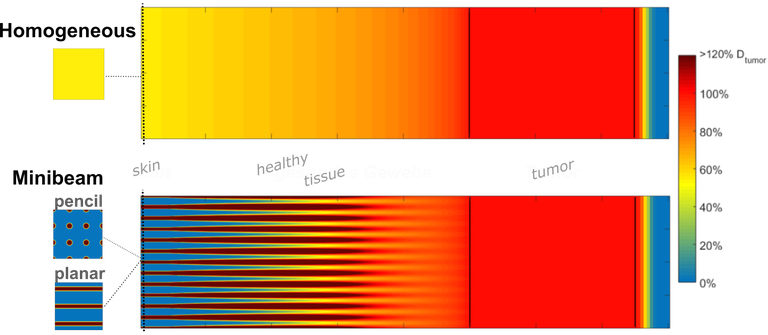Proton Minibeam Radiotherapy
Concept of Proton Minibeam Radiotherapy
In the radiotherapy of tumors, the risk of developing normal tissue injuries often limits the radiation dose that can be applied to the tumor. Proton Minibeam radiotherapy has been developed at the ion microbeam SNAKE in Munich to reduce damage in normal tissues, particularly the skin. The use of submillimeter proton beams enables the spatial fractionation of the irradiation, i.e. dose is only applied to small areas of the irradiation field on the skin. Tumor control is maintained as in conventional radiotherapy via a homogeneous tumor dose, which is obtained in the tumor by widening of the minibeams via interactions of the protons with the traversed tissue. The homogeneous irradiation of the tumor is achieved by individually adjusted optimization of the minibeam distances to tumor size and position. Also heterogeneous dose distributions in the tumor with a high minimum dose, which result from an interlacing of minibeams from several directions with large minibeam distances, can provide tumor control with even lower side effects.
The reduced side effects of minibeam irradiations have already been demonstrated in several in vivo studies in the mouse ear model on SNAKE, also investigating the influence of minibeam size and a temporal fractionation.

Concept for a preclinical proton minibeam irradiation facility
In order to demonstrate the advantages of the innovative irradiation method with proton minibeams under realistic, therapeutic conditions, a pre-clinical irradiation facility is being designed. This new facility is supposed to be constructed at the accelerator lab of the TUM and LMU Munich in Garching and will use large parts of the existing infrastructure. Besides the already performed irradiation of mouse ears, plans are to irradiate tissues like muscle, lung, brain and even tumors in small animals. This cannot be performed with the protons from the existing accelerator with a range in tissue of approx. 4 mm, but will require higher energies – and thus ranges of approx. 40 mm – achieved by a post-accelerator.
The technical challenge is to keep the high brilliance of the beam from the tandem accelerator with the post-accelerator in order to be able to focus the proton beam to a beam size of 0.1 mm. The most promising accelerator technology is a high-frequency linear accelerator, as is being developed in two groups in Europe for standard proton therapy facilities. First simulations show that the beam quality of the accelerated proton beam lies in the desired range for focusing.
Currently, a group at the LRT2 institute is working on an optimized focusing system under the given constraints with the help of beam optical simulations. Furthermore, the selection of suitable hardware and software components is required to be able to build such a post-accelerator as well as the following focusing system and experimental site.